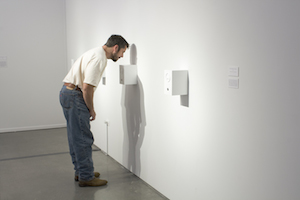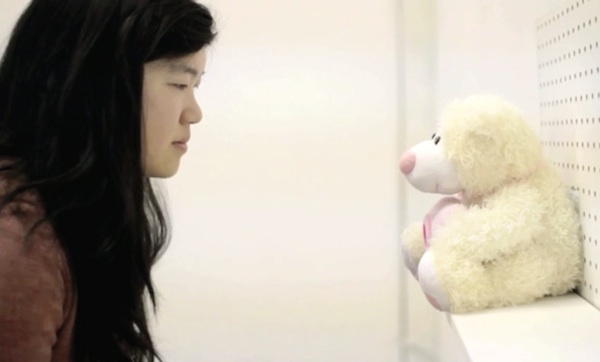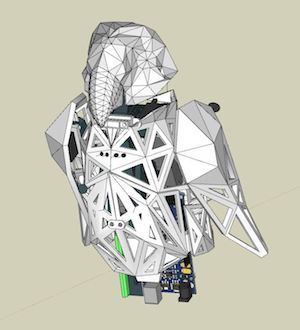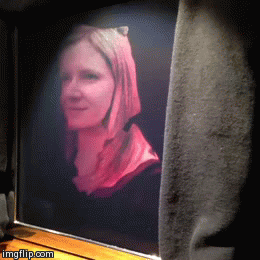Skanect was pretty easy to use. I'm not totally happy with the mesh from this first run result, so I'll have to work on refining either my scanning technique or learning how to smooth meshes in Blender.
Wednesday, December 03, 2014
First run with Kinect Xbox & Skanect
So I went ahead and picked up a Kinect for Xbox and Skanect (for Mac). By the way, the Kinect came with a power supply, so I didn't need to purchase a separate power supply.
Skanect was pretty easy to use. I'm not totally happy with the mesh from this first run result, so I'll have to work on refining either my scanning technique or learning how to smooth meshes in Blender.
Skanect was pretty easy to use. I'm not totally happy with the mesh from this first run result, so I'll have to work on refining either my scanning technique or learning how to smooth meshes in Blender.
Saturday, November 22, 2014
Dorkbot SoCal 57 on Dec. 7
Dorkbot SoCal 57
***** Sunday, December 7, 2014***** 12:00 noon to 2:00pm
***** Machine Project
***** 1200 D North Alvarado Street
***** Los Angeles, CA 90026
***** Google map of Machine Project
Speakers will include...
Brian Goeltzenleuchter
http://www.bgprojects.com
Scenting the antiseptic institution For over eight years Brian Goeltzenleuchter has designed olfactory-based art installations which disseminate scent in one of the most antiseptic of institutions, the art museum. While designing evocative smells might appear to be the olfactory artist's primary creative challenge, Brian's presentation will point to another challenge that is often overlooked for its technical and creative potential: The device itself used to transmit the scent. Using as case studies four recent art projects, Brian's Dorkbot presentation will consider a variety of scent distribution devices - from lower tech to higher tech - and offer technical, poetic and conceptual justification for his choice of each. The presentation will conclude with a description of a forthcoming project, and a challenge to the audience to identify solutions to the challenges it poses in distributing scent.


Soyoung Shin
http://soyoungshin.com
Soyoung lives in Los Angeles, California, USA. She graduated in 2011 from the University of Washington with a Bachelors of Science in Computer Science. She has a post-disciplinary practice that includes sculpture, performance, video, photography, and technology. Soyoung enjoys the intersection of media and science, and her work uses new technologies to create connections between viewers and ideas. Using found advertisements and a readymade discount robotic teddy bear, "THE 50% OFF BALLET" calls attention toward underlying attitudes which frame Valentine's Day. This piece places the viewer in a position where they are provided messaging from media ranging from musical typical of the holiday, to what could be considered perverse.

Brian Matthews
http://www.flappingsprocket.com
Since engineer/artist Brian Matthews made his first pair of mechanical wings in 1998, wing making became his passion. He has made 17 pairs of wings varying in materials and operation from simple pulley opening to pneumatics and robotic control. Most recently, he built a robotic "extra hand", and a 3D printed robotic parrot called "Pollymer".


Adam Florin
http://loommakesmusic.com/
Adam will present a software system for creating generative music called Loom. Loom produces music by using random number generation to distort its internal model of musical "gesture". The project came out of his research and practice at CalArts.

Wednesday, November 12, 2014
Receiving Multicast on Ubuntu 12.04.4 LTS
If you are running Ubuntu 12.04.4 LTS, you may be surprised that you cannot receive multicast packets in your programs using the normal socket interface, but then you run tcpdump and can receive the multicast packets just fine. You also might be surprised that you can send multicast packets just fine from your programs, but cannot receive them.
It turns out that you need to do this (as root):
echo 2 > /proc/sys/net/ipv4/conf/eth0/rp_filter
On every interface you wish to receive multicast packets on.
If you want the changes to rp_filter to be permanent, you need to add the changes to /etc/sysctl.conf and you may also want to tweak /etc/sysctl.d/10-network-security.conf
A great way to test the reception of multicast packets is "mcfirst", part of the ssmping package ("apt-get install sampling" to install). mcfirst will let you listen to any group,port on any network interface.
"netstat -gn" will show you which multicast groups your network interfaces are subscribed to.
It turns out that you need to do this (as root):
echo 2 > /proc/sys/net/ipv4/conf/eth0/rp_filter
On every interface you wish to receive multicast packets on.
If you want the changes to rp_filter to be permanent, you need to add the changes to /etc/sysctl.conf and you may also want to tweak /etc/sysctl.d/10-network-security.conf
A great way to test the reception of multicast packets is "mcfirst", part of the ssmping package ("apt-get install sampling" to install). mcfirst will let you listen to any group,port on any network interface.
"netstat -gn" will show you which multicast groups your network interfaces are subscribed to.
Tuesday, November 04, 2014
Open vSwitch on Ubuntu
OMG, don't try to build Open vSwitch from source if you can avoid it, if you are on Ubuntu just follow these steps to apt-get it, and then it builds the database and runs itself.
The problem is that most normal people just want to run ovs in a VM with mininet, but I wanted to run it on a real bare-metal server with actual traffic.
The problem is that most normal people just want to run ovs in a VM with mininet, but I wanted to run it on a real bare-metal server with actual traffic.
Saturday, October 04, 2014
Tuesday, September 23, 2014
Kinect-based 3D scanning software
I am looking for some alternatives to 123D Catch. Here is one, KScan3D, which says "With KScan3D software and Kinect or Xtion sensors, you can scan real objects and export 3D models in minutes."
Other options include Skanect, and Reconstruct Me.
Apparently Skanect has a Mac OS X version, and can work with Structure Scanner (attached to your iOS device and streams to your OS X computer), or Asus Xtion & Primesense Carmine and Kinect for Xbox (but not Kinect for Windows). Details on use with OS X are here.
Other options include Skanect, and Reconstruct Me.
Apparently Skanect has a Mac OS X version, and can work with Structure Scanner (attached to your iOS device and streams to your OS X computer), or Asus Xtion & Primesense Carmine and Kinect for Xbox (but not Kinect for Windows). Details on use with OS X are here.
Saturday, September 20, 2014
Dorkbot SoCal 56 - The Reboot, Oct. 19
Dorkbot SoCal 56 - The Reboot
***** Sunday, October 19, 2014***** 11:00 am to 1:00pm
***** Machine Project
***** 1200 D North Alvarado Street
***** Los Angeles, CA 90026
***** Google map of Machine Project
Speakers will include...
Garnet Hertz
http://www.conceptlab.com
Dorkbot SoCal's overlord emeritus has moved to Vancouver, but will return to us through the power of videoconferencing to narrate his travelogue of the Chinese maker/hacker culture including the 2014 Shenzhen Maker Faire, Seeed Studio, theChaihuo Hackerspace in Shenzhen, as well as the Xin Che Jian Hackerspace in Shanghai.
Garnet is now the Canada Research Chair in Design and Media Arts at Emily Carr University of Art + Design in Vancouver Canada, and previously was previously Artist in Residence and Research Scientist in Informatics at UC Irvine. And he has built robots controlled by cockroaches :)

Thomas Edwards
http://www.t11s.com
Thomas will talk about how you can use 3D capture software such as 123D Catch to make your own digital holograms with Zebra Imaging.

Safecast bGeigie build event in Santa Monica
bGeigie Workshop Santa Monica, CA November 1-2, 2014.
Build a GPS-enabled, data-logging, hand-held radiation detector, learn about citizen radiation monitoring, and connect with a growing network of people motivated to measure radiation in their environment and share their data with others.
Safecast, the Natural Resources Defense Council (NRDC) and IMI International Medcom, Inc. will host a bGeigie workshop at NRDC's offices in Santa Monica, CA on Saturday, November 1 and Sunday, November 2, 2014. During the first day of the workshop, participants will solder and assemble Safecast's Good Design-winning bGeigie, learn how to use their detectors, and hear from individuals and groups involved in citizen radiation monitoring. During the second day of the workshop, trips will be arranged for participants to log radiation measurements in the field, and practice uploading and mapping their data.
Read blogs from Safecast co-founder Sean Bonner, IMI International Medcom’s CEO Dan Sythe and NRDC health physicist Bemnet Alemayehu about the bGeigie workshop we held in Washington, DC this past spring. For more information or to register for the event, please contact NRDC’s Matthew McKinzie atmmckinzie@nrdc.org. The bGeigie kits for this event (cost $450) can be ordered in advance from IMI International Medcom. Please let us know if you or your organization would like to inquire about support to participate, as we want to grow this community.
Wednesday, January 22, 2014
Making a Full Color White Light Hologram
Using 123D Catch iPhone app, I captured a model of my wife Carla, and then took that an made an 8x10" full-color white light hologram from Zebra Imaging:
My thoughts: 123D Catch is pretty easy to use to capture a 3D mesh. Making the hologram from the mesh on 123Dapp.com was pretty easy as well - they interface well with Zebra Imaging. I probably should have fixed up the mesh a bit in Blender or MeshLab, but I had to use a coupon before it expired. The hologram has a kind of "grid" to it, but you don't tend to notice it very much. The hologram is not very efficient, you need to illuminate it with a very bight light to see anything. I ended up purchasing an Ikea Jansjo Desk Work Led Lamp Light, which does a good job of illuminating the hologram because it is a point source, single white LED. Pretty awesome!
Here is what the mesh looked like in MeshLab after I captured it:
My thoughts: 123D Catch is pretty easy to use to capture a 3D mesh. Making the hologram from the mesh on 123Dapp.com was pretty easy as well - they interface well with Zebra Imaging. I probably should have fixed up the mesh a bit in Blender or MeshLab, but I had to use a coupon before it expired. The hologram has a kind of "grid" to it, but you don't tend to notice it very much. The hologram is not very efficient, you need to illuminate it with a very bight light to see anything. I ended up purchasing an Ikea Jansjo Desk Work Led Lamp Light, which does a good job of illuminating the hologram because it is a point source, single white LED. Pretty awesome!
Here is what the mesh looked like in MeshLab after I captured it:
Crashspace's Sparkles in 3D
I did a quick 3D model of Crashspace's "Sparkles" the pony soldering iron using the iPhone 123D Catch app, here are the results in MeshLab:
Needs some work in Blender. You can see that I put Sparkles on top of a drill press to capture the model.
Needs some work in Blender. You can see that I put Sparkles on top of a drill press to capture the model.
Subscribe to:
Posts (Atom)











